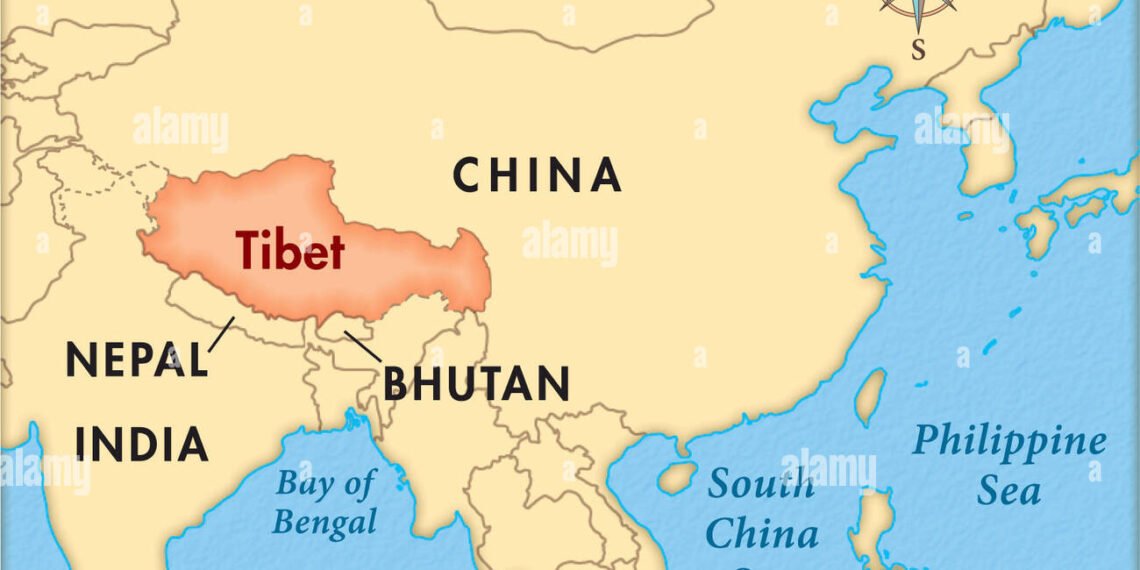China hails it as a peaceful liberation. Tibetans call it a coerced annexation. 74 years since the signing of the Seventeen Point Agreement, this deep-dive revisits the past, the consequences, and the contested present.
BY Navin Upadhyay
On the 74th anniversary of China’s annexation of Tibet, marked by the coerced signing of the Seventeen Point Agreement on May 23, 1951, the global Tibetan community has risen in a poignant act of remembrance and defiance. From the exile hub of Dharamsala to the streets of Geneva and New York, Tibetans and their supporters have rallied to denounce the agreement as a fraudulent document that stripped away Tibet’s de facto independence, condemning ongoing Chinese policies that threaten their cultural survival.
This milestone, steeped in historical pain, has sparked protests, vigils, and impassioned posts on X, amplifying a call for self-determination that resonates across borders but struggles against the weight of global geopolitics. The world’s response, though sympathetic in pockets, reveals a troubling inertia, as economic ties with China often mute calls for justice. Yet the Tibetan spirit, unbroken after decades of hardship, continues to demand recognition and autonomy, making this anniversary not just a moment of reflection but a rallying cry for a people’s enduring fight.
In Dharamsala, the Central Tibetan Administration, the government-in-exile, issued a searing statement on X, declaring that May 23, 1951, marked the day “Tibet’s independence was buried under a coerced agreement.” The CTA, led by the Dalai Lama’s vision of the Middle Way, reaffirmed its pursuit of genuine autonomy within China, while highlighting the ongoing cultural erosion—most notably, the forced placement of over 1 million Tibetan children in Chinese-run boarding schools designed to sever their linguistic and cultural roots. Across the globe, the Tibetan Youth Congress and groups like the Tibet Action Institute echoed this sentiment, organizing candlelight vigils and protests outside Chinese embassies.
READ: Special NIA Court in Churachandpur to Handle Manipur Ethnic Violence Cases
Their X posts, brimming with hashtags like #FreeTibet and #TibetResists, linked the 1951 annexation to the 1959 Lhasa Uprising, framing it as the spark of a resistance that burns today. Activists like Lhadon Tethong emphasized the plight of Tibetan youth, noting that 78% of students face assimilationist education, a policy they decry as cultural genocide. In cultural festivals from London to Washington, D.C., the diaspora showcased traditional music, dance, and Buddhist teachings, while the CTA announced plans to digitize Tibetan texts, a quiet but powerful act to preserve an identity under siege.
“Today marks the 74th anniversary of the agreement that buried the independence of Tibet. This agreement was repudiated by His Holiness the 14th Dalai Lama in 1959 after eight years of trying to find common ground within the agreement’s framework. However, all points in the…
— Tibet.Net (@CTA_TibetdotNet) May 23, 2025
Beyond the Tibetan community, global reactions to the anniversary reveal a fractured landscape of support and caution. Advocacy groups like the International Campaign for Tibet and Free Tibet have been unequivocal, labeling Tibet an “independent state under illegal occupation” and calling for sanctions on Chinese officials complicit in human rights abuses. Their reports spotlight China’s interference in Tibetan Buddhist practices, including control over the Dalai Lama’s succession, as a violation of religious freedom. The European Parliament, in a May 8, 2025, resolution, condemned China’s assimilation policies, urging protection for Tibetan identity, yet stopped short of challenging Beijing’s sovereignty claim.
READ: Myanmar Resistance Stands by Abduction, Torture Claims
In the United States, Secretary of State Antony Blinken has drawn parallels between China’s surveillance in Tibet—such as forced DNA collection—and its repression of Uyghurs, but no official statement marked the anniversary, a silence that speaks volumes about economic dependencies.
Media outlets like Tibetan Review contrasted China’s March 28, 2025, “Serfs Emancipation Day” celebrations with Tibetan protests, framing the 1951 agreement as the root of ongoing oppression. On X, voices like @HistoryTibetan, “74 years of occupation began with a forced agreement. Tibet’s fight continues,” capturing a public sentiment that leans toward Tibetan self-determination, though some users note the complexity of Tibet’s pre-1951 international status.
China, predictably, remains steadfast in its narrative. State media, while not specifically addressing May 23, reiterated through recent white papers that Tibet’s integration was a “peaceful liberation,” bringing economic progress via infrastructure like the Qinghai-Tibet Railway. Accounts like @ShangguanJiewen cite a 1951 telegram from the Dalai Lama to Mao Zedong as evidence of consent, though Tibetans dismiss it as coerced. Beijing brands independence advocates as separatists, warning against foreign interference.
Meanwhile, India, host to the Dalai Lama and over 100,000 Tibetan refugees, remains a silent giant. Indian commentators on X express regret over Jawaharlal Nehru’s 1951 inaction, believing it sealed Tibet’s fate, yet no official statement emerged on the anniversary, likely due to ongoing border tensions with China in Ladakh.
The historical roots of this day lie in Tibet’s de facto independence from 1912 to 1950, when it operated as a sovereign state with its own government, currency, and army, despite lacking formal international recognition. The 1914 Simla Convention acknowledged Tibetan autonomy, but China’s rejection set the stage for conflict. In October 1950, the People’s Liberation Army invaded eastern Tibet, crushing the Tibetan army at Chamdo and forcing negotiations.
The Seventeen Point Agreement, signed under duress in Beijing, promised autonomy but delivered subjugation, as Tibetan delegates lacked authority to consent. The Dalai Lama, then 15, ratified it under pressure but repudiated it in 1959, fleeing to India after the Lhasa Uprising left thousands dead. In 1951, Tibetans greeted the agreement with dismay, while China celebrated it as unification. The international community, distracted by the Korean War, offered little beyond rhetoric, with India urging autonomy and the UN issuing a toothless condemnation.
The agreement’s failure to deliver autonomy fueled decades of resistance. The 1959 uprising, cultural devastation during the Cultural Revolution, and an estimated 1.2 million Tibetan deaths underscore its legacy. Today, Han Chinese migration and policies like boarding schools continue to marginalize Tibetans, a process critics call cultural genocide. Scholars argue the annexation violated international law, as Tibet was a de facto independent state, yet UN resolutions from 1959 to 1965 lacked enforcement. The agreement’s coerced nature undermines its legitimacy, but China’s global influence stifles challenges.
The 74th anniversary lays bare a stark reality: Tibet’s struggle endures in a world where sympathy often outpaces action. The global Tibetan community’s resilience—through protests, cultural preservation, and digital advocacy—stands in sharp contrast to the geopolitical pragmatism that mutes stronger international support. China’s narrative of progress clashes with evidence of cultural erasure, leaving Tibetans to fight for their identity against overwhelming odds. This day, a wound that refuses to heal, reminds us that the quest for justice, though daunting, remains alive in the hearts of those who refuse to forget.













